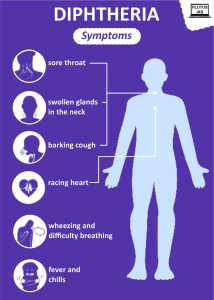21 Oct Diphtheria
This article covers “Daily Current Affairs” and the topic details “Diphtheria”. This topic has relevance in the Social Issue section of the UPSC CSE exam.
For Prelims:
About Diphtheria?
For Mains:
GS 2: Social Issue
Complications of Diphtheria?
Diagnosis of Diphtheria?
Why in the news?
The World Health Organization (WHO) has announced the occurrence of a diphtheria outbreak, which is a severe infection caused by specific bacteria known as Corynebacterium diphtheria.
About Diphtheria
Diphtheria is a severe and potentially life-threatening bacterial infection that primarily impacts the mucous membranes of the nose and throat, and in some cases, it can affect the skin as well. It is caused by the bacterium Corynebacterium diphtheriae, which produces a toxin capable of causing damage to various tissues and organs within the body.
Symptoms of Diphtheria:
- Symptoms of diphtheria usually manifest 2 to 5 days after exposure to the bacteria. The most common and distinctive symptom is the development of a thick, greyish membrane that covers the throat and tonsils, obstructing the airway and making it difficult to breathe and swallow. Additional symptoms may include:
- Sore throat and hoarseness
- Swelling of the glands in the neck
- Fever and chills
- Nasal discharge
- Cough and wheezing
- Fatigue
- Some individuals infected with diphtheria may experience mild or even no symptoms at all, but they can still serve as carriers of the disease, potentially spreading it to others.
- Diphtheria can also manifest as a skin infection, resulting in ulcers covered by a grey membrane, along with symptoms like redness, swelling, and pain. This form of diphtheria is more commonly observed in tropical climates and among populations with inadequate hygiene practices and crowded living conditions.

Complications of Diphtheria:
Diphtheria can lead to severe complications if left untreated or if treatment is delayed. The toxin produced by the bacterium can affect various organs and systems in the body, resulting in the following complications:
- Myocarditis: This is inflammation of the heart muscle, which can cause abnormal heart rhythms, heart failure, and, in some cases, death.
- Peripheral Neuropathy: Diphtheria can damage the nerves, leading to paralysis of limbs, eye muscles, and the diaphragm (the muscle essential for breathing), potentially resulting in respiratory failure.
- Kidney Problems: Diphtheria can affect the kidneys, causing proteinuria (the presence of protein in the urine), kidney failure, and, in severe cases, death.
- Bleeding Problems: Due to reduced levels of platelets (blood cells responsible for clotting), individuals with diphtheria may experience symptoms such as bruising, bleeding gums, nosebleeds, and internal bleeding.
It’s important to note that the risk of death from diphtheria is higher in children under 5 years old and adults over 60 years old.
Diagnosis of Diphtheria:
Diphtheria is diagnosed through a combination of physical examinations and laboratory tests using samples taken from the throat or skin. The diagnostic tests include:
- Throat Culture: A swab is used to collect a sample from the throat or membrane, which is then cultured in a specialized medium to identify the presence of the diphtheria-causing bacteria.
- Elek Test: This test is employed to detect the presence of the toxin produced by the diphtheria bacteria.
Treatment of Diphtheria:
- Diphtheria is treated using two main types of medications:
- Diphtheria Antitoxin: This medication neutralizes the toxin produced by the diphtheria bacteria. It is administered as an injection as soon as possible after diagnosis.
- Antibiotics: Medications such as erythromycin and penicillin are used to kill the bacteria or inhibit their growth. These antibiotics are given either orally or intravenously and are typically administered for 10 to 14 days.
- Individuals with diphtheria must be isolated in a hospital, often in an intensive care unit, to prevent the further spread of the infection and to closely monitor their condition. Supportive care, including oxygen therapy, fluids, pain relief, and, in some cases, a tracheostomy (a surgical procedure to create an opening in the windpipe) to aid breathing, may also be necessary.
- Close contacts of individuals with diphtheria may require preventive treatment with antibiotics and vaccination.
Prevention of Diphtheria:
- The most effective way to prevent diphtheria is through vaccination. The diphtheria vaccine is typically administered as part of a combination vaccine that also protects against tetanus and pertussis (whooping cough). It is recommended for various age groups, with booster doses every 10 years for adolescents and adults.
- The vaccine is generally safe, with mild side effects such as pain, redness, swelling at the injection site, fever, headache, and fatigue, and serious allergic reactions are extremely rare.
Download plutus ias current affairs eng med 21th Oct 2023
Q.1 Consider the following statements about Diphtheria:
- Diphtheria primarily affects the skin and is caused by a toxin produced by Streptococcus bacteria.
- Diphtheria is not a severe infection and rarely leads to life-threatening complications.
Which of the statements given above is/are correct?
(a) 1 only
(b) 2 only
(c) Both 1 and 2
(d) Neither 1 nor 2
Q.2 Consider the following statements about Diphtheria:
- Diphtheria antitoxin is administered to neutralize the diphtheria toxin.
- The most effective method for preventing diphtheria is through vaccination with the diphtheria vaccine
Which of the statements given above is/are correct?
(a) 1 only
(b) 2 only
(c) Both 1 and 2
(d) Neither 1 nor 2
Q.3 Analyze the challenges and achievements of recent vaccination campaigns, and propose recommendations for improving the effectiveness and accessibility of vaccination programs in the country.



No Comments